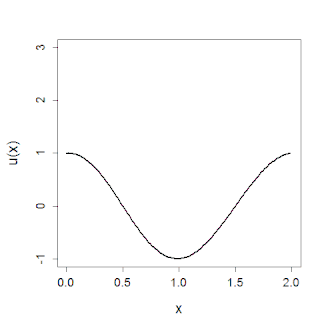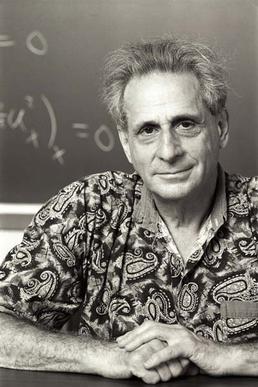This is a list of integrable models as well as classes of integrable models in physics.
This is a list of integrable models as well as classes of integrable models in physics.
In classical and quantum field theory:

In mathematics and physics, a soliton or solitary wave is a self-reinforcing wave packet that maintains its shape while it propagates at a constant velocity. Solitons are caused by a cancellation of nonlinear and dispersive effects in the medium. Solitons are the solutions of a widespread class of weakly nonlinear dispersive partial differential equations describing physical systems.
In a supersymmetric theory the equations for force and the equations for matter are identical. In theoretical and mathematical physics, any theory with this property has the principle of supersymmetry (SUSY). Dozens of supersymmetric theories exist. Supersymmetry is a spacetime symmetry between two basic classes of particles: bosons, which have an integer-valued spin and follow Bose–Einstein statistics, and fermions, which have a half-integer-valued spin and follow Fermi–Dirac statistics. In supersymmetry, each particle from one class would have an associated particle in the other, known as its superpartner, the spin of which differs by a half-integer. For example, if the electron exists in a supersymmetric theory, then there would be a particle called a selectron, a bosonic partner of the electron. In the simplest supersymmetry theories, with perfectly "unbroken" supersymmetry, each pair of superpartners would share the same mass and internal quantum numbers besides spin. More complex supersymmetry theories have a spontaneously broken symmetry, allowing superpartners to differ in mass.
The Ising model, named after the physicists Ernst Ising and Wilhelm Lenz, is a mathematical model of ferromagnetism in statistical mechanics. The model consists of discrete variables that represent magnetic dipole moments of atomic "spins" that can be in one of two states. The spins are arranged in a graph, usually a lattice, allowing each spin to interact with its neighbors. Neighboring spins that agree have a lower energy than those that disagree; the system tends to the lowest energy but heat disturbs this tendency, thus creating the possibility of different structural phases. The model allows the identification of phase transitions as a simplified model of reality. The two-dimensional square-lattice Ising model is one of the simplest statistical models to show a phase transition.
The sine-Gordon equation is a nonlinear hyperbolic partial differential equation for a function dependent on two variables typically denoted and , involving the wave operator and the sine of .

In mathematics, the Korteweg–De Vries (KdV) equation is a mathematical model of waves on shallow water surfaces. It is particularly notable as the prototypical example of an exactly solvable model, that is, a non-linear partial differential equation whose solutions can be exactly and precisely specified. KdV can be solved by means of the inverse scattering transform. The mathematical theory behind the KdV equation is a topic of active research. The KdV equation was first introduced by Boussinesq and rediscovered by Diederik Korteweg and Gustav de Vries (1895).

Martin David Kruskal was an American mathematician and physicist. He made fundamental contributions in many areas of mathematics and science, ranging from plasma physics to general relativity and from nonlinear analysis to asymptotic analysis. His most celebrated contribution was in the theory of solitons.
In mathematics, integrability is a property of certain dynamical systems. While there are several distinct formal definitions, informally speaking, an integrable system is a dynamical system with sufficiently many conserved quantities, or first integrals that its motion is confined to a submanifold of much smaller dimensionality than that of its phase space.
The Kramers–Wannier duality is a symmetry in statistical physics. It relates the free energy of a two-dimensional square-lattice Ising model at a low temperature to that of another Ising model at a high temperature. It was discovered by Hendrik Kramers and Gregory Wannier in 1941. With the aid of this duality Kramers and Wannier found the exact location of the critical point for the Ising model on the square lattice.

In mathematics and physics, the Kadomtsev–Petviashvili equation is a partial differential equation to describe nonlinear wave motion. Named after Boris Borisovich Kadomtsev and Vladimir Iosifovich Petviashvili, the KP equation is usually written as
The quantum Heisenberg model, developed by Werner Heisenberg, is a statistical mechanical model used in the study of critical points and phase transitions of magnetic systems, in which the spins of the magnetic systems are treated quantum mechanically. It is related to the prototypical Ising model, where at each site of a lattice, a spin represents a microscopic magnetic dipole to which the magnetic moment is either up or down. Except the coupling between magnetic dipole moments, there is also a multipolar version of Heisenberg model called the multipolar exchange interaction.
In mathematics, the inverse scattering transform is a method for solving some non-linear partial differential equations. The method is a non-linear analogue, and in some sense generalization, of the Fourier transform, which itself is applied to solve many linear partial differential equations. The name "inverse scattering method" comes from the key idea of recovering the time evolution of a potential from the time evolution of its scattering data: inverse scattering refers to the problem of recovering a potential from its scattering matrix, as opposed to the direct scattering problem of finding the scattering matrix from the potential.
A charge density wave (CDW) is an ordered quantum fluid of electrons in a linear chain compound or layered crystal. The electrons within a CDW form a standing wave pattern and sometimes collectively carry an electric current. The electrons in such a CDW, like those in a superconductor, can flow through a linear chain compound en masse, in a highly correlated fashion. Unlike a superconductor, however, the electric CDW current often flows in a jerky fashion, much like water dripping from a faucet due to its electrostatic properties. In a CDW, the combined effects of pinning and electrostatic interactions likely play critical roles in the CDW current's jerky behavior, as discussed in sections 4 & 5 below.

The Landau–Zener formula is an analytic solution to the equations of motion governing the transition dynamics of a two-state quantum system, with a time-dependent Hamiltonian varying such that the energy separation of the two states is a linear function of time. The formula, giving the probability of a diabatic transition between the two energy states, was published separately by Lev Landau, Clarence Zener, Ernst Stueckelberg, and Ettore Majorana, in 1932.
Dispersionless limits of integrable partial differential equations (PDE) arise in various problems of mathematics and physics and have been intensively studied in recent literature. They typically arise when considering slowly modulated long waves of an integrable dispersive PDE system.

Vladimir E. Korepin is a professor at the C. N. Yang Institute of Theoretical Physics of the Stony Brook University. Korepin made research contributions in several areas of mathematics and physics.
In quantum physics, the quantum inverse scattering method (QISM) or the algebraic Bethe ansatz is a method for solving integrable models in 1+1 dimensions, introduced by Leon Takhtajan and L. D. Faddeev in 1979.
In physics, Liouville field theory is a two-dimensional conformal field theory whose classical equation of motion is a generalization of Liouville's equation.
In mathematics, the Novikov–Veselov equation is a natural (2+1)-dimensional analogue of the Korteweg–de Vries (KdV) equation. Unlike another (2+1)-dimensional analogue of KdV, the Kadomtsev–Petviashvili equation, it is integrable via the inverse scattering transform for the 2-dimensional stationary Schrödinger equation. Similarly, the Korteweg–de Vries equation is integrable via the inverse scattering transform for the 1-dimensional Schrödinger equation. The equation is named after S.P. Novikov and A.P. Veselov who published it in Novikov & Veselov (1984).
Olaf Lechtenfeld is a German mathematical physicist, academic and researcher. He is a full professor at the Institute of Theoretical Physics at Leibniz University, where he founded the Riemann Center for Geometry and Physics.